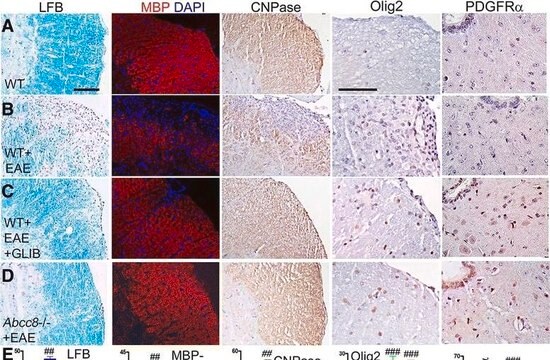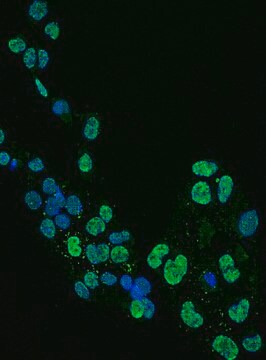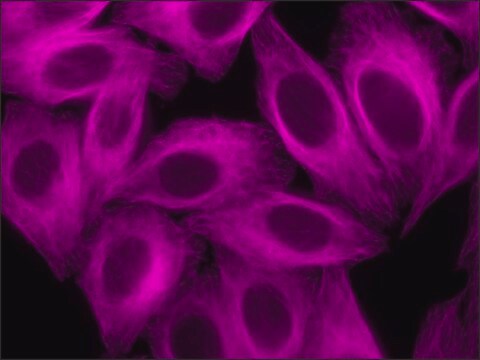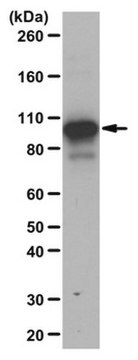ABE1024
Anti-Oligodendrocyte transcription factor 2 (OLIG2 Antibody)
serum, from guinea pig
Synonym(s):
Oligodendrocyte transcription factor 2, Oligo2
Sign Into View Organizational & Contract Pricing
All Photos(2)
About This Item
UNSPSC Code:
12352203
eCl@ss:
32160702
NACRES:
NA.41
Recommended Products
biological source
guinea pig
Quality Level
antibody form
serum
antibody product type
primary antibodies
clone
polyclonal
species reactivity
mouse, human
technique(s)
immunohistochemistry: suitable (paraffin)
western blot: suitable
NCBI accession no.
UniProt accession no.
shipped in
dry ice
target post-translational modification
unmodified
General description
Oligodendrocyte transcription factor 2 (OLIG2), also known as Oligodendrocyte transcription factor 2 Oligo2, Class B basic helix-loop-helix protein 1 (bHLHb1), Class E basic helix-loop-helix protein 19 (bHLHe19), Protein kinase C-binding protein 2, Protein kinase C-binding protein RACK17, is encoded by the gene name OLIG2/ BHLHB1/ BHLHE19/ PRKCBP2/ RACK17. Olig2 is required for oligodendrocyte and motor neuron specification in the spinal cord, as well as for the development of somatic motor neurons in the hindbrain. It cooperates with OLIG1 to establish the pMN domain of the embryonic neural tube. Olig2 is an antagonist of V2 interneuron and of NKX2-2-induced V3 interneuron development. The restricted expression of Olig2 in oligodendrocytes makes AB9610 an excellent marker of oligodendroglia and oligodendrogliomas in development and mature systems. Olig2 is expressed in the brain and oligodendrocytes. Olig2 is strongly expressed in oligodendrogliomas, while expression is weak to moderate in astrocytomas. Expression in glioblastomas highly variable.
Immunogen
Epitope: Unknown
KLH-conjugated linear peptide corresponding to mouse Oligodendrocyte transcription factor 2 (OLIG2).
Application
Immunohistochemistry Analysis: A 1:250 dilution from a representative lot detected Oligodendrocyte transcription factor 2 (OLIG2) in human cortical brain section tissue.
Research Category
Neuroscience
Neuroscience
Research Sub Category
Developmental Signaling
Developmental Signaling
This Anti-Oligodendrocyte transcription factor 2 (OLIG2 antibody is validated for use in WB, IH(P) for the detection of Oligodendrocyte transcription factor 2 (OLIG2.
Quality
Evaluated by Western Blotting in mouse brain tissue lysate.
Western Blotting Analysis: A 1:1;000 dilution of this antibody detected Oligodendrocyte transcription factor 2 (OLIG2) in 10 µg of mouse brain tissue lysate.
Western Blotting Analysis: A 1:1;000 dilution of this antibody detected Oligodendrocyte transcription factor 2 (OLIG2) in 10 µg of mouse brain tissue lysate.
Target description
~37 kDa observed
Physical form
Guinea pig polyclonal serum with 0.05% sodium azide.
Unpurified
Storage and Stability
Stable for 1 year at -20°C from date of receipt.
Handling Recommendations: Upon receipt and prior to removing the cap, centrifuge the vial and gently mix the solution. Aliquot into microcentrifuge tubes and store at -20°C. Avoid repeated freeze/thaw cycles, which may damage IgG and affect product performance.
Handling Recommendations: Upon receipt and prior to removing the cap, centrifuge the vial and gently mix the solution. Aliquot into microcentrifuge tubes and store at -20°C. Avoid repeated freeze/thaw cycles, which may damage IgG and affect product performance.
Other Notes
Concentration: Please refer to lot specific datasheet.
Disclaimer
Unless otherwise stated in our catalog or other company documentation accompanying the product(s), our products are intended for research use only and are not to be used for any other purpose, which includes but is not limited to, unauthorized commercial uses, in vitro diagnostic uses, ex vivo or in vivo therapeutic uses or any type of consumption or application to humans or animals.
Not finding the right product?
Try our Product Selector Tool.
Storage Class
10 - Combustible liquids
wgk_germany
WGK 1
Certificates of Analysis (COA)
Search for Certificates of Analysis (COA) by entering the products Lot/Batch Number. Lot and Batch Numbers can be found on a product’s label following the words ‘Lot’ or ‘Batch’.
Already Own This Product?
Find documentation for the products that you have recently purchased in the Document Library.
Michaela Fredrich et al.
Hippocampus, 27(5), 495-506 (2017-01-19)
The hippocampus is subjected to diurnal/circadian rhythms on both the morphological and molecular levels. Certain aspects of cell proliferation in the adult hippocampus are regulated by melatonin and accompanied by apoptosis to ensure proper tissue maintenance and function. The present
Marc Oria et al.
Frontiers in molecular neuroscience, 15, 888351-888351 (2022-07-06)
During embryonic spinal cord development, neural progenitor cells (NPCs) generate three major cell lines: neurons, oligodendrocytes, and astrocytes at precise times and locations within the spinal cord. Recent studies demonstrate early astrogenesis in animal models of spina bifida, which may
Our team of scientists has experience in all areas of research including Life Science, Material Science, Chemical Synthesis, Chromatography, Analytical and many others.
Contact Technical Service






